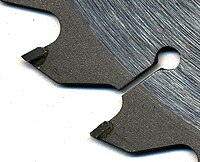
Photo from wikipedia
Abstract Interfacial debonding is detrimental for the properties of diamond/Cu composites, which can be solved by diamond surface metallization with active element Cr. Using microstructure characterization and statistical investigation, we… Click to show full abstract
Abstract Interfacial debonding is detrimental for the properties of diamond/Cu composites, which can be solved by diamond surface metallization with active element Cr. Using microstructure characterization and statistical investigation, we find that the diamond surface metallization undergoes dispersed growth, preferred growth, complete metallization and preferred cleavage. The preferred carbide growth on {100} surfaces and preferred carbide cleavage on {111} surfaces result from the different surface configurations. Furthermore, an amorphous carbon layer generates at diamond (111)/carbide interface for the structure transformation. Interfacial bonding between diamond and Cu is realized via reaction bonding at diamond/carbide interface and diffusion bonding at carbide/Cu interface.
Journal Title: Scripta Materialia
Year Published: 2018
Link to full text (if available)
Share on Social Media: Sign Up to like & get
recommendations!